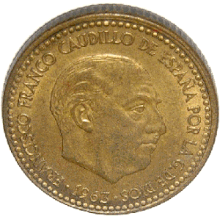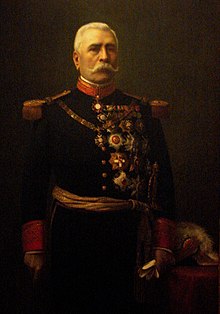Caudillo
Men characterized as caudillos have ruled in Cuba (Gerardo Machado, Fulgencio Batista, Fidel Castro), Panama (Omar Torrijos, Manuel Noriega), the Dominican Republic (Desiderio Arias, Cipriano Bencosme), Paraguay (Alfredo Stroessner), Argentina (Juan Perón and other military strongmen), and Chile (Augusto Pinochet).In Spanish America, new sovereign states grappled with the question of balancing a central authority, usually in the hands of the traditional elites, with some kind of representation of the new "citizenry" of the republics.These regimes attempted to curtail centrifugal forces, often termed "federalism", where regions or states of a nation-state had more autonomy and instead established the hegemony of the central government.According to political scientist Peter H. Smith, these include Juan Manuel de Rosas in Argentina; Diego Portales of Chile, whose system lasted nearly a century; and Porfirio Díaz of Mexico.The quintessential Mexican caudillo, who gained national power for decades, was Santa Anna, who was initially a Liberal but became a Conservative and sought strengthening of the central government.Following the Mexican–American War, regional caudillos such as Juan Álvarez of the state of Guerrero and Santiago Vidaurri of Nuevo León-Coahuila ousted Santa Anna in the Revolution of Ayutla, bringing Liberals to power.Álvarez follows the pattern of the "folk caudillo", whom historian François Chevalier calls a "good cacique, [who] protected the mainly indigenous and mestizo peasants of Guerrero, who in turn gave him their loyalty".[30] Álvarez briefly served as President of Mexico, returning to his home state, leaving ideological liberals to institute the era of La Reforma.Important figures whose local power had consequences nationally included Mariano Escobedo in San Luis Potosí; Ramón Corona in Jalisco and Durango; and Porfirio Díaz in parts of Veracruz, Puebla, and Oaxaca.There were other caudillos whose power was more local but still important, including Gerónimo Treviño and Francisco Narajo in Nuevo León, Servando Canales and Juan Cortina in Tamaulipas, Florencio Antillón in Guanajuato, Ignacio Pesqueira in Sonora, Luis Terrazas in Chihuahua, and Manuel Lozada in Tepic.Those opponents gravitated to supporting Díaz, a military hero of the French intervention, who challenged Juárez and Lerdo by attempting rebellions, the second of which, the Plan of Tuxtepec, was successful in 1876."[32] Simón Bolívar, the foremost leader of independence in Spanish America, attempted to recreate the Viceroyalty of New Granada in the nation of Gran Colombia.As with Mexico and Central America, the political turmoil and penury of the governments of the Bolivarian republics prevented foreign investors from risking their capital there.Like Paraguay's Jose Gaspar Rodriguez de Francia, Belzu chose to enact the aforementioned welfare programs because the idea of communalism was more in tune with the traditional values of native populations than the emphasis on private property that other caudillos embraced.His enemies wanted to destroy the state-run projects that helped nationalist program but likewise improved the public sphere on which the country's poor were reliant.[35] In contrast to most of Spanish America, post-independence Chile experienced political stability under the authoritarian rule of conservatives, backed by the landowning class.In Paraguay, José Gaspar Rodríguez de Francia (r. 1814–1840) was Supreme Dictator of the Republic, maintaining the landlocked country's independence from Argentina and other foreign powers.He has been a controversial figure in Hispanic American history: many modern historians credit him with bringing stability to Paraguay, preserving independence, and "bequeathing to his successors an egalitarian, homogeneous nation".[40] "Sometimes counted among the dictators of the era, contemporary history has viewed Francia as an honest, populist leader who promoted sovereign economic prosperity in a war-torn Paraguay.Stable political regimes that could ensure the security of foreign investments, facilitate extraction of resources, and production of agricultural crops and animals were the necessary structures.Pancho Villa also helped oust Díaz, supported Madero, and following his murder in 1913, became a general in the Constitutionalist Army commanded by civilian Venustiano Carranza.Emiliano Zapata, peasant leader from the state of Morelos, opposed to Díaz and every subsequent Mexican government until his murder in 1919 by Carranza's agents.During Calles's presidency (1924–1928), he stringently enforced the anticlerical laws of the Mexican Constitution of 1917, leading to the Cristero War, a failed major uprising under the leadership of some regional caudillos, including Saturnino Cedillo of San Luis Potosí.[18][19] Colombian Nobel Prize winner Gabriel García Márquez published two works with strongmen as main characters: The Autumn of the Patriarch[45] and The General in his Labyrinth, the latter a controversial novel about Simón Bolívar.[46] In 1946, Nobel Prize laureate Miguel Ángel Asturias published El Señor Presidente, based on the life of Manuel Estrada Cabrera (1898–1920), which was translated to English in 1975.







Caudillo (film)Spanish pesetaGeneralísimoFrancisco Francoby the Grace of GodJuan Manuel de RosasCayetano DescalziOld Spanishpersonalist leader wielding military and political powermilitary dictatorwarlordstrongmanHispanic AmericaReconquistaconquistadorsHernán CortésFrancisco Pizarrocolonial eraJohn LynchSpanish American wars of independenceEmilio AguinaldoPhilippinesSecond Spanish RepublicSpanish Civil WarauthoritarianmajorityList of Hispanic American caudillosAntonio López de Santa AnnaInstitutional Revolutionary PartyGerardo MachadoFulgencio BatistaFidel CastroOmar TorrijosManuel NoriegaDesiderio AriasAlfredo StroessnerJuan PerónAugusto PinochetpatronageJuan Facundo Quirogapopulistcontinuismoliberal or conservativefederalismRoman Catholic ChurchviceroyaltiesAgustín de IturbideSimón BolívarJosé de San MartínAntonio José de SucreFrancisco de MirandaMiguel Hidalgo y CostillaJosé Gervasio ArtigasPeter H. SmithDiego PortalesPorfirio DíazSanta AnnaRafael CarreraFrancisco MorazánFederal Republic of Central AmericaMexicoliberalismMexican–American WarJuan ÁlvarezSantiago VidaurriNuevo LeónCoahuilaRevolution of AyutlaFrançois ChevalierLa ReformaFrench intervention in MexicoMariano EscobedoSan Luis PotosíRamón CoronaJaliscoDurangoJuan CortinaTamaulipasFlorencio AntillónSonoraLuis TerrazasChihuahuaManuel LozadaBenito JuárezSebastián Lerdo de TejadaPlan of TuxtepecZacatecasVeracruzTampicoJuan N. MéndezMatamorosViceroyalty of New GranadaGran Colombiapresident-for-lifeauthoritarianismBoliviaManuel Isidoro BelzuJose Miguel de VelascoParaguayJose Gaspar Rodriguez de FranciaViceroyalty of Río de la PlataBuenos Aires ProvincegauchosFructuoso RiveraJosé Gaspar Rodríguez de FranciaFacundo QuirogaTomás Cipriano de MosqueraJuan Rafael Mora PorrasPedro SantanaJuan José FloresManuel José ArceJosé María MorelosJosé Anacleto OrdóñezGaspar Rodríguez de FranciaAgustín GamarraJosé Antonio PáezcolonialneocolonialismSomoza familyPorfiriatoRuralesMexican Revolution1910 general electionManuel GonzálezPascual OrozcoFrancisco I. Madero